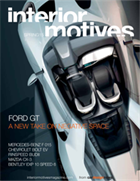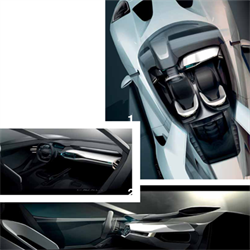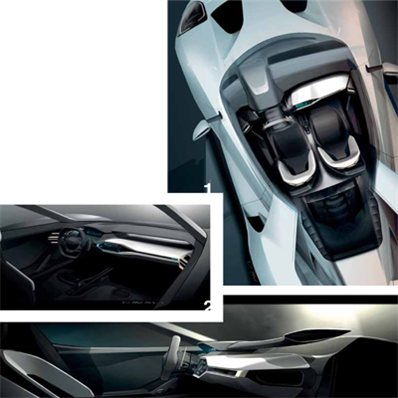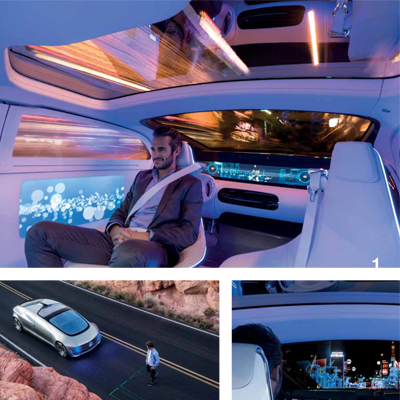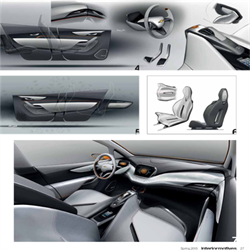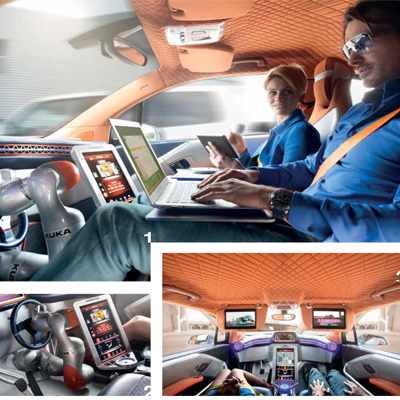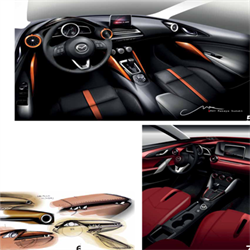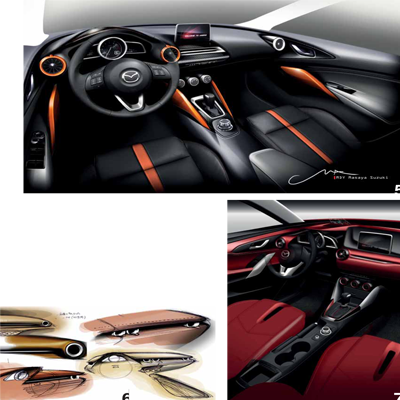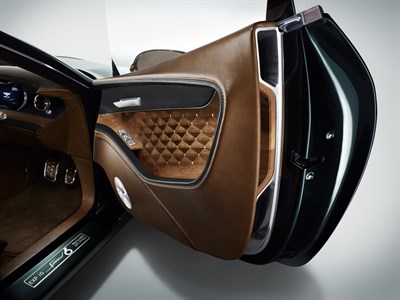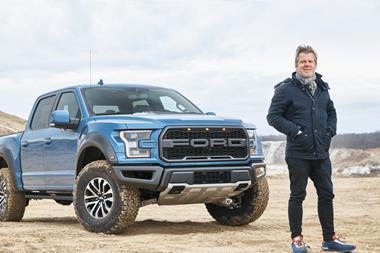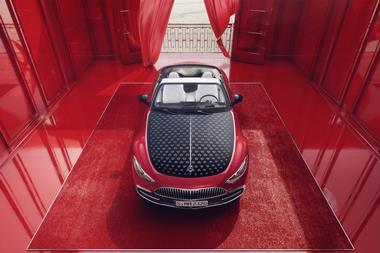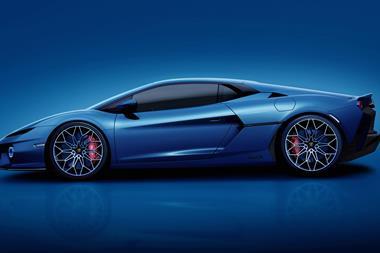IN THIS ISSUE

Vice president of design Moray Callum
Director of interior design Amko Leenarts
Interior design manager (vision phase) Bill Mangan
Designers Nir Siegel, Adam Phillips
Interior design manager (design phase) Peng Hao
Interior designer Dave McCall
Colour & trim Vincent Lobry
Project started November 2013
Project completed December 2014
Launch Detroit / January 20154
The 2016 Ford GT is the third iteration of the GT40/GT and does not follow J May's retro-futuristic 2005 car in its style, but is instead a departure both technically and design-wise from its predecessors.
Any GT has to act as both a halo car and a statement of intent for Ford, and this new car is intriguing too from this perspective, because it represents the new vanguard of Ford Design.
Its development is the first full programme to be completed with Moray Callum as Ford vice president of design, Chris Svensson as design director of Ford Americas and Amko Leenarts as global director of interior design. “It’s a real icon,” says Leenarts. “From day one, we all felt the excitement and greatness of the responsibility for the company.”
 Vehicle type Concept / autonomous electric car
Vehicle type Concept / autonomous electric carChief design officer Gorden Wagener
Chief interior designer Hartmut Sinkwitz
Interior, colour & trim project leader Kmichele Jauch-Paganetti
Colour & trim designers Simona Falcinella
Project manager Englebert Rozyn
UX team leader Vera Schmidt
UX designers Konstantin Fick, Marco Plewe, Joseph Fagan, Gabriel Nguyen, Alexander Hilliger von Thiele
Project started March 2013
Project completed October 2014
Launched Las Vegas / January 2015
Like Milan Design Week, the Consumer Electronics Show (CES) in Las Vegas, USA, is an increasingly popular event for carmakers, who can reveal their new ideas beyond the traditional motorshow audiences.
Isolated centre consoles or roofless interior bucks have become more common at CES in recent years, as these are the most likely parts of a car to feature hardware and software developments of interest, but Mercedes-Benz went one step further in January 2015 by choosing to unveil the first complete concept car at CES.
The F 015 Luxury in Motion was presented as a research vehicle to reinforce a new design aesthetic, functionally appropriate for a future vehicle circa 2030 likely to feature autonomous driving and high levels of connectivity and interactivity.
Mercedes-Benz places high importance on producing fully-working concepts, and proved this point by a few very public ‘drives’ down the nearby Las Vegas Strip. While the functional prototype uses the drivetrain from the SLS AMG Electric Drive supercar, the F 015 is envisioned to have a hydrogen fuel cell powertrain to enable an enhanced range of almost 700 miles (1100km). With no conventional internal combustion engine in the front – or even a regular driver’s seat – a single-volume vehicle was decided upon from the outset to maximise the interior space.
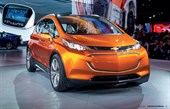 Vehicle type Production / subcompact
Vehicle type Production / subcompactDesign director, GM Australia Design Richard Felazzo
Inerior chief designer Frank Rudolph
Interior design manager Joe Rudolph
Interior Designer EHarsha Ravig
Colour and trim manager Jenny Morgan-Douralis
Colour and trim designer Krista Lindegger
Concept execution and build MGM Australia Design
Project Started Summer 2014
Project Completed January 2015
Launch Detroit / January 2015
 Vehicle type Concept car / city car
Vehicle type Concept car / city carDesign director Frank M. Rinderknecht
Project manager Peter Kagi
Prototype engineering 4erC
Technical implementation / final assembly Esoro
Interior design Hornschurch, Strahle+Hess
Project started June 2014
Project completed February 2015
Launched Geneva / March 2015
Last year, Frank M. Rinderknecht made autonomous driving the subject for discussion in his autopilot-enabled XchangE concept, based on Tesla Model S. And with this year's Budii - Rinspeed's 21st concept car, built for display at the Geneva Motor Show - Rinderknecht's Rinspeed think tank has gone one step further. As its name suggests, Budii is meant to be a personified 'friend on wheels', a car that can adapt to its driver's habits and preferences, a cognitive 'transurban' vehicle which collects, processes and stores data and information from its environment. Its development informed by research from Ernst & Young, it explores the emerging new relationship between driver and car in the forthcoming autonomous age.
 Vehicle type Production / compact crossover
Vehicle type Production / compact crossover
Executive officer Mazda design Ikuo Maeda
Director of design Mazda North American Operations Derek Jenkins
Interior design manager Mazda North American Operations Julien Montouss
Chief designer Youichi Matsuda
Interior designer Hiroaki Saito
Colour materials designer Yukina Kimura
Project started Spring 2013
Project completed January 2014
Launched Los Angeles / November 2014
“And therefore we don’t want you to do anything but drive and enjoy the driving.” Montousse, interior designer of the 2010 Shinari concept, has been guiding the interior thematic of Mazda’s so-called ‘sixth-generation’ designs (the latest CX-5, the MX-5, Mazda 2, Mazda 3 and Mazda 6 and now the all-new CX-3 compact crossover) and he feels “there is a lot of common ground we have between those interiors that trickles down all the way to the CX-3”.
This stems from the Shinari: “That was the first vehicle to really showcase the driver-centric architecture,” he says. “And from that architecture, we influenced the whole sixth generation of cars.” Alongside the creation of this more sharply driver-focused environment, Mazda’s interior designers have been further tasked with reaching a new level of interior sophistication And for the CX-3 in particular, Montousse says that “we wanted to bring a boutique-y product for this price range; something more dedicated to driving, and mature in a way, even if it is a small vehicle.”
He worked with Youichi Matsuda and his team at Mazda’s studio in Hiroshima, “influencing the theme from the Shinari” as the CX-3 was developed for production.
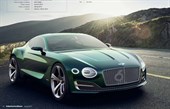
Head of interior design Brett Boydell
Lead interior designer Jonathan Punter
Interior Styling Concept Aaron Post
Design development Ben Quaintance
Colour and trim design Verena Thomas, Cathy Bass
Head of design modelling Kevin Baker
Project started Autumn 2013
Project completed Spring 2015
Launch Geneva / March 2015
This two-seater sports car began under the radar within Bentley's advanced design department but the project also involved wider VW Group input and capabilities.
Head of interior design Brett Boydell explains: "We started about 18 months ago in autumn 2013 with the initial concept and ideation work. It was actually a collaboration with Potsdam design studio. We worked alongside Romulus Rost and Stefan Sielaff, and one of their designers came to the UK and stayed with us to see it through. It was just a ssmall design team of three designers and myself leading the project on the interior, under Luc Donckerwolke's direction.
Magazine
